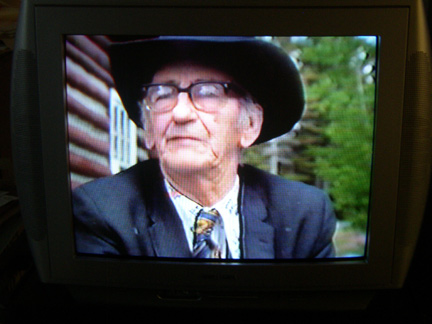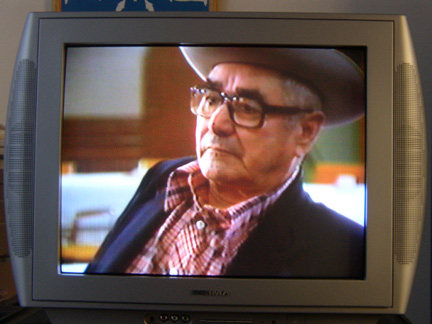|
Maurice L'Hirondelle Former President, FMSA
bigger
|
Start 1930-31 1932 1933
1934 1935-38 1939 1940-41
In 1930, the Natural Resources Transfer Agreements were signed between the western provinces and the federal government. As a result, the Métis, who had for years petitioned the federal government on land issues, for example, at St. Paul des Métis, knew that in Alberta they had to deal with the provincial government, although they continued to press the federal government for action. With the transfer the federal position was that Métis were now under provincial jurisdiction and flatly denied any responsibility. Still, the federal department of Indian Affairs kept a watchful eye on the situation as it developed at the provincial level.
Métis policy in Alberta began to be shaped on May 24, 1930 when at the invitation of Chas. Delorme, Joe Dion, a non-treaty Indian, attended a meeting of Métis at Fishing Lake. These were likely the same people who had been badly treated by the Church at St. Paul.
Dion’s appointment as the Métis representative was a critical event and happened only after numerous meetings in the 1920s that prepared the groundwork. Up to that point, Métis representatives had few concrete results to show. Dion was surprised to be asked but agreed to be the Métis spokesperson, dealing with “authorities in Edmonton.” His main task was to secure land for the Métis in the Fishing Lake/Frog Lake area. He was a homesteader and a teacher in a federal Indian school and he came to the job with extensive experience working with government and Church officials. As he put it himself, he had joined Métis “agitation.”
He began work in earnest almost immediately in May and June 1930, just prior to the provincial election. Lodas Joly, a CCF candidate in that election attended the first meeting (probably in June) of about fifty Métis. There, Joly expressed his support for Métis land and relief efforts. So, it appeared the provincial government might have been in agreement with their efforts to reduce the impact of the Depression on already destitute people.
And so the Métis movement began to take shape. There were a number of meetings in 1931 and 1932. For example, on June 7, 1931 an open air meeting at Cold Lake drew about 200 Métis. Support also came from various politicians. One was the local St. Paul Liberal MLA, J. M. Dechene who lived about sixteen miles away from his friend Joe Dion. He met government officials expressing his concerns on behalf of the Métis. He, by the way, defeated Joly in the 1930 election. And so the momentum picked up. Dechene who had great sympathy for the terrible conditions in which Métis in this area were living became a significant supporter of what quickly became widely known as the Métis “movement.” The numbers were growing. Métis were reported to be coming to the Fishing Lake area from as far away as the NWT and the USA.
Dechene persuaded Reid, the Minister of Lands and Mines in the UFA/CCF government, to hear Dion out.
So, knowing the context in the early 1930s is important. Remember that in 1932 the Depression was in full swing. Hunger marches throughout the province worried the government. Also, tensions between Métis and non-Métis settlers, particularly in the north, around land use were pointing to another potential “up-rising.” Métis in the south had related concerns; conditions for them were no better. The movement became province-wide, not just centred on the Fishing Lake area. At the same time, those in the Fishing Lake/St. Paul area had had significant influence on removing Lodas Joly, the government’s incumbent MLA in 1930, and electing a Liberal, Dechene.
**The majority of the writers are the executive council of the newly
formed l'Association des Métis d'Alberta et les Territoires du Nord-Ouest in December 1932: Joseph
Francis Dion, President, Malcolm F. Norris, First Vice-President, James Patrick
Brady, Secretary Treasurer, and in January 1934, Peter C. Tomkins elected as
Third Vice-President. Some letters and reports are by the politicians
responsible for Metis welfare: Joseph M. Dechene, a Liberal MLA, Richard Gavin
Reid (CCF Minister of Lands and Mines and Premier in 1934), George Hoadley (CCF
Minister of Agriculture and acting-Premier at times), J. E. Brownlee (CCF
Premier), W. W. Cross (from 1935 the Social Credit, Minister of Health), William
Aberhart (Social Credit Premier) and others; and there are those written by the
bureaucrats involved in developing and administering Metis policy: J. Harvie
(Reid's Deputy Minister), Frank Buck (Cross' lead bureaucrat in the Bureau of
Relief and Public Welfare***), J. Rankine (a solicitor for Harvie and eventually
the secretary of the Ewing Commission) and
others. ***after 1939 the name is the Bureau of Public Welfare. |


